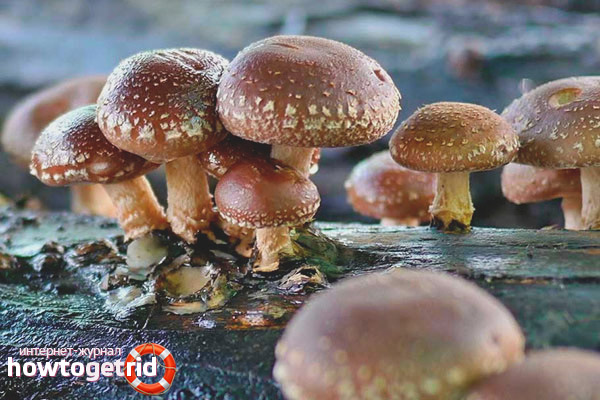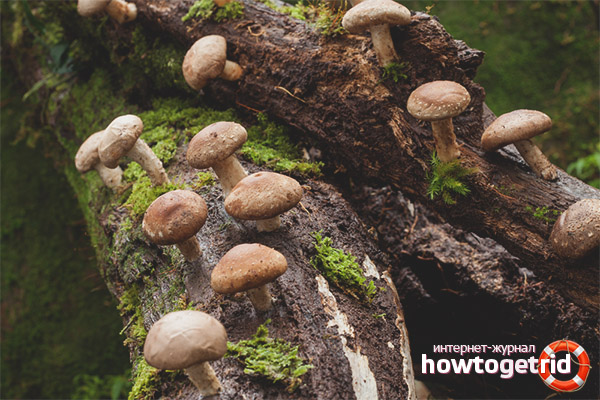The content of the article
This mushroom has many different names. It was popular in ancient times, when it was the basis of the imperial dishes of Asian rulers. Due to this historical fact, the described mushroom has got a beautiful name - “imperial mushroom”. Now it is widely used in the preparation of various dishes. In cosmetics, its extracts are actively used. In addition, doctors also note its useful qualities.
What does a mushroom look like?
In diameter, the convex cap of the mushroom ranges from 5 to 20 cm. And its shape looks like a hemisphere. The surface of dry skin has a small amount of white scales. To the touch, the skin on the hat is somewhat reminiscent of velvet. And its color has shades ranging from coffee to brown-brown. An indicator that the mushroom has ripened is the flattening of the shape of the cap and the possible cracking of the skin. But these signs relate to edible lentinal. The largest weight of the mushroom was 100 grams.
The plates of the young fungus are covered with a thin layer of a protective membrane. Their interesting feature under mechanical action is the change in color shade.
The maximum length of a straight and fibrous leg, which gradually becomes thinner to the ground, was 19 cm. The size of the hat itself is no higher than the mark of a half centimeter. The color of the legs of the imperial mushroom can be either beige or brown.
Mushroom fleshy flesh has a specific pungent flavor and excellent aroma. The formation of dark spots on its underside is indicative of the loss of all the main advantages and overriding of the imperial delicacy.
White spores have an elliptical shape, which is characteristic of lamellar ones. They are located below under the head of the emperor’s mushroom.
Shiitake growth medium
In Asian countries, shiitake can be found growing on stumps and fallen trees. The presence of the fungus is found on many and very different trees, one of which is a mulberry tree. The Shiitake season begins in spring. Its group bearing occurs all summer and lasts until late autumn. Lentinile growth is very fast. It goes through the full maturation process in just 8 days. Recently, a tiny bead-sized hat on day 8 is already becoming a full-grown ripe mushroom.
Similar views
Although the shiitake has an eye-catching exotic note, it is not difficult to confuse it with ordinary champignons. It will be very difficult to distinguish them from several particularly similar types of champignons. These species have the same color on their bodies as described by the emperor’s mushrooms. The most obvious sign that will surely never make champignon confused with shiitake is the growth of the former only on well-decayed ground. In addition, mushrooms can not be found in the spring, like the imperial mushroom.
Shiitake rules

Only hats with delicate soft flesh are suitable for food. The legs of the fungus are not in demand due to their rigid fiber structure. Asians do not accept the methods of Europeans for cooking mushrooms. Asians do not dry mushrooms like Europeans, but use them for culinary purposes immediately. Indeed, among them there is an opinion that after drying their spicy taste can be forgotten. The mushroom goes for the preparation of various soups and sauces, can be served together with mouth-watering meat or fish.Mushrooms can also be served separately as a delicacy. Thermally unprocessed mushrooms will appeal to their particular taste of picky gourmets.
Nutritional value
The number of kilocalories in the emperor's mushroom is about 34.
The raw product consists of:
- Carbohydrates - 6.8 grams.
- Protein - 2.2 grams.
- Fat - 0.5 grams.
What is the use of the mushroom?
The unique taste of shiitake was discovered 1000 years ago. And already, starting from the 14th century, it began to be used by Chinese healers as healing poultices.
The very end of the 20th century was marked by a thorough study of its pulp, which proved not only its usefulness, but also its therapeutic effect.
Healing properties in the fungus are present due to the content of important elements:
- All vitamins of groups B, vitamins C and D.
- Minerals Fe, Mg, Ca, K, P, Na, Zn, Mn and Se.
- Highly active antitumor polysaccharide-lentinan.
- The hormone lignan.
- Glutamic and other acids.
- Coenzymes
As you can see, such a particularly rich chemical composition will have a significant effect on the human body, especially if it has:
- Various problems with the heart muscle (coronary heart disease, atherosclerosis, and many others).
- Excess blood glucose.
- High cholesterol.
- Gastrointestinal problems.
- Diseases of the endocrine system.
- Chronic fatigue.
- Sclerosis.
- Skin problems.
- The presence of viruses in the body.
- Bacteriological diseases.
- Candidiasis.
- Cancerous diseases.
- Sick liver.
- Weakened protective function of the body.
- Sluggish potency.
- Urological diseases.
Nutritionists successfully use this mushroom species for their own purposes. Side effects of anticancer drugs can be reduced by using extracts based on shiitake mycelium. According to Chinese medicine, it is able to prolong human longevity. Mushrooms find their use in different dietary supplements.
Thanks to its revitalizing features, imperial mushrooms have successfully entered even cosmetology. Means based on it perfectly cope with many skin problems (oiliness, age spots and others). Well-known manufacturers of branded cosmetics did not fail to take advantage of an extract from the imperial mushroom. The states of the East do not stop considering him the secret of youth.
Who is contraindicated in?
A large level of bioactivity of the fungus prohibits its use in certain conditions:
- People suffering from hypersensitivity of the body.
- Respiratory tract disease.
- Pregnancy and lactation.
- Childhood.
Growing Shiitake at Home
Now the mushroom is spreading around the world at an active pace. Until the mid-20th century, the shiitake mushroom was bred by the primitive method of rubbing incisions of a rotten tree with fruiting bodies. Since the middle of the last century, mankind has comprehended the craft of their proper cultivation. The beginning of the 21st century has already been marked by the production of shiitake in the amount of 800 thousand tons per year.
Edible lentinula can be grown on logs in sunlight or on simple sawdust. When breeding shiitake on an oak log, it retains all its basic properties, which makes it wild. The second method, although slightly increasing the strength of the aroma and taste of the fungus, but acts to the detriment of its healing properties.
Undemanding shiitake to its natural range allows you to grow them at home. Thus, the observance of some important conditions and support of the natural environment guarantees success in their breeding. From May to October, excellent fruiting of these mushrooms is observed. But breeding shiitake is not the easiest process.
Is it possible to grow a culture on a stump?
The cultivation of the fungus is impossible without the presence of a woody structure. A trunk or a simple wooden stump is ideal, which ideally needs to be cut into bars 50 cm long. Cutting is not required only if you intend to plant a crop in a summer cottage.It is very important to stock up on the intact wood structure in early spring. It should have no rot and moss.
The very moment of laying the mycelium should be preceded by filling the wood with moisture and its disinfection. All this is achieved by boiling in water for an hour. At its completion, you need to cut holes in the centimeter, with a depth of 7 cm. Put the mycelium shiitake in these holes, covering them with moist cotton. Moisture in wood should not be lower than 15%, and not higher than 70%. A plastic bag is perfect for possible wood moisture loss.
Do not forget about observing the temperature regime. This is an essential condition for the successful cultivation of mushrooms. The optimum temperature for Japanese mushrooms is 16 degrees during the day, 10 degrees at night.
Are straw and sawdust suitable for culture?
If wood is not your option, then you can try using the most common wood chips or straw. As in the previous method, you need to resort to boiling materials. And the addition of bran or oilcake malt will cause an increase in the fertility of mushrooms. Already finished seedlings need to be covered with a plastic bag, which will provide a temperature of up to 20 degrees. After visible signs of mycelium seedlings, the temperature can already be reduced to 15 degrees during the day and up to 10 degrees at night.
If the woody method of growing involves the use of containers, then with straw it is not necessary. Steamed straw is placed in an ordinary bag in several layers, between which the mycelium is placed. In such a bag, then holes should be cut through which mushrooms will grow. A good crop will be ensured with painstaking control over the desired temperature.
Video: shiitake - the king of medicinal mushrooms











Submit